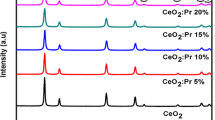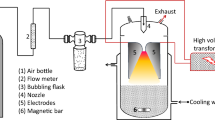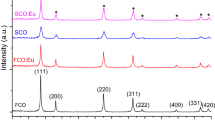Abstract
Thermally stable blue nonstoichiometric nanoceria was produced by feeding nanoceria with an average size of 50 nm into a DC thermal plasma reactor. The effects of different plasma power levels and atmospheres were investigated. XRD results showed the ceria lattice parameter increased with plasma power. SEM and TEM results showed that the shape of nanoparticles changed after plasma treatment; the blue nonstoichiometric nanoceria had highly regular shapes such as triangular pyramids and polyhedral in contrast to the irregular shape of the raw nanoceria. Significant downshift was found in the Raman spectra of the plasma products, with a 7.9-cm−1 shift compared with raw nanoceria, which was explained by the reduction of Ce4+. X-ray photoelectron spectroscopy results showed that the Ce3+ fraction increased from 14% in the raw nanoceria to 38–39% for the product CeO2-x , indicating the high reduction state on the ceria surface. It was determined that this blue nonstoichiometric nanoceria was stable up to 400 °C in air, but the color changed to pale yellow after 4 h at 500 °C in air indicating oxidation to CeO2. Additionally, this novel stable nano-CeO2-x caused a red shift in the UV-visible absorption results; a 48-nm red shift occurred for the nonstoichiometric nanoceria produced at 15 kW compared with the raw nanoceria. The band gap was calculated to be 2.5 eV while it was 3.2 eV for the raw nanoceria, indicating that this novel stable blue nonstoichiometric nanoceria should be a promising material for optical application.








Similar content being viewed by others
References
Ackermann S, Sauvin L, Castiglioni R, Rupp JL, Scheffe JR, Steinfeld A (2015) Kinetics of CO2 reduction over nonstoichiometric ceria. J Phys Chem C 119:16452–16461
Ananthapadmanabhan P, Thiyagarajan T, Sreekumar K, Venkatramani N (2004) Formation of nano-sized alumina by in-flight oxidation of aluminium powder in a thermal plasma reactor. Scr Mater 50:143–147
Bishop S, Duncan K, Wachsman E (2009) Defect equilibria and chemical expansion in non-stoichiometric undoped and gadolinium-doped cerium oxide. Electrochim Acta 54:1436–1443
Blumenthal R, Lee P, Panlener R (1971) Studies of the defect structure of nonstoichiometric cerium dioxide. J Electrochem Soc 118:123–129
Borchert H, Frolova YV, Kaichev VV, Prosvirin IP, Alikina GM, Lukashevich AI, Zaikovskii VI, Moroz EM, Trukhan SN, Ivanov VP (2005) Electronic and chemical properties of nanostructured cerium dioxide doped with praseodymium. J Phys Chem B 109:5728–5738
Chiang YM, Lavik E, Kosacki I, Tuller H, Ying J (1996) Defect and transport properties of nanocrystalline CeO2-x. Appl Phys Lett 69:185–187
Chueh WC, Falter C, Abbott M, Scipio D, Furler P, Haile SM, Steinfeld A (2010) High-flux solar-driven thermochemical dissociation of CO2 and H2O using nonstoichiometric ceria. Science 330:1797–1801
Dawicke JW, Blumenthal RN (1986) Oxygen association pressure measurements on nonstoichiometric cerium dioxide. J Electrochem Soc 133:904–909
Esch F, Fabris S, Zhou L, Montini T, Africh C, Fornasiero P, Comelli G, Rosei R (2005) Electron localization determines defect formation on ceria substrates. Science 309:752–755
Feng X, Sayle DC, Wang ZL, Paras MS, Santora B, Sutorik AC, Sayle TX, Yang Y, Ding Y, Wang X (2006) Converting ceria polyhedral nanoparticles into single-crystal nanospheres. Science 312:1504–1508
Gao W, Zhang Z, Li J, Ma Y, Qu Y (2015) Surface engineering on CeO2 nanorods by chemical redox etching and their enhanced catalytic activity for CO oxidation. Nano 7:11686–11691
Gilman W, Seabaugh P, Sullenger D (1968) Stable substoichiometric cerium oxide formed in an air plasma. Science 160:1239–1239
Holgado JP, Alvarez R, Munuera G (2000) Study of CeO2 XPS spectra by factor analysis: reduction of CeO2. Appl Surf Sci 161:301–315
Hong SJ, Virkar AV (1995) Lattice parameters and densities of rare-earth oxide doped ceria electrolytes. J Am Ceram Soc 78:433–439
Huang Y, Yan CF, Guo CQ, Huang SL (2015) Enhanced photoreduction activity of carbon dioxide over Co3O4/CeO2 catalysts under visible light irradiation. Int J Photoenergy 2015:30808
Iwasaki B, Katsura T (1971) The thermodynamic properties of the nonstoichiometric ceric oxide at temperatures from 900 to 1300° C. B Chem Soc Jpn 44:1297–1301
Kosacki I, Petrovsky V, Anderson HU, Colomban P (2002) Raman spectroscopy of nanocrystalline ceria and zirconia thin films. J Am Ceram Soc 85:2646–2650
Lee Y, He G, Akey AJ, Si R, Flytzani-Stephanopoulos M, Herman IP (2011) Raman analysis of mode softening in nanoparticle CeO2-δ and Au-CeO2-δ during CO oxidation. J Am Chem Soc 133:12952–12955
Liu X, Zhou K, Wang L, Wang B, Li Y (2009) Oxygen vacancy clusters promoting reducibility and activity of ceria nanorods. J Am Chem Soc 131:3140–3141
McBride J, Hass K, Poindexter B, Weber W (1994) Raman and x-ray studies of Ce1-xRExO2- y, where RE=La, Pr, Nd, Eu, Gd, and Tb. J Appl Phys 76:2435–2441
Mogensen M, Sammes NM, Tompsett GA (2000) Physical, chemical and electrochemical properties of pure and doped ceria. Solid State Ionics 129:63–94
Nörenberg H, Briggs G (1997) Defect structure of nonstoichiometric CeO2 (111) surfaces studied by scanning tunneling microscopy. Phys Rew Lett 79:4222
Nagata T, Miyajima K, Hardy RA, Metha GF, Mafune F (2015) Reactivity of oxygen deficient cerium oxide clusters with small gaseous molecules. J Phys Chem A 119:5545–5552
Neish AC (1909) Preparation of pure cerium salts and the color of cerium oxide. J Am Chem Soc 31:517–523
Qiu L, Liu F, Zhao L, Ma Y, Yao J (2006) Comparative XPS study of surface reduction for nanocrystalline and microcrystalline ceria powder. Appl Surf Sci 252:4931–4935
Ricken M, Nölting J, Riess I (1984) Specific heat and phase diagram of nonstoichiometric ceria (CeO2-x). J Solid State Chem 54:89–99
Ryu T, Sohn HY, Hwang KS, Fang ZZ (2009) Plasma synthesis of tungsten carbide nanopowder from ammonium paratungstate. J Nanopart Res 92:655–660
Sayle DC, Feng X, Ding Y, Wang ZL, Sayle TX (2007) “Simulating synthesis”: ceria nanosphere self-assembly into nanorods and framework architectures. J Am Chem Soc 129:7924–7935
Taniguchi T, Watanabe T, Sugiyama N, Subramani A, Wagata H, Matsushita N, Yoshimura M (2009) Identifying defects in ceria-based nanocrystals by UV resonance Raman spectroscopy. J Phys Chem C 113:19789–19793
Tuller H, Nowick A (1979) Defect structure and electrical properties of nonstoichiometric CeO2 single crystals. J Electrochem Soc 126:209–217
VanHandel G, Blumenthal R (1974) The temperature and oxygen pressure dependence of the ionic transference number of nonstoichiometric CeO2-x. J Electrochem Soc 121:1198–1202
Verma R, Samdarshi S, Bojja S, Paul S, Choudhury B (2015) A novel thermophotocatalyst of mixed-phase cerium oxide (CeO2/Ce2O3) homocomposite nanostructure: role of interface and oxygen vacancies. Sol Energy Mater Sol Cells 141:414–422
Wang HF, Li HY, Gong XQ, Guo YL, Lu GZ, Hu P (2012) Oxygen vacancy formation in CeO2 and Ce1-xZrxO2 solid solutions: electron localization, electrostatic potential and structural relaxation. Phys Chem Chem Phys 14:16521–16535
Wang K, Chang Y, Lv L, Long Y (2015) Effect of annealing temperature on oxygen vacancy concentrations of nanocrystalline CeO2 film. Appl Surf Sci 351:164–168
Wu Z, Li M, Howe J, Meyer HM III, Overbury SH (2010) Probing defect sites on CeO2 nanocrystals with well-defined surface planes by Raman spectroscopy and O2 adsorption. Langmuir 26:16595–16606
Ying JY, Tschöpe A (1996) Synthesis and characteristics of non-stoichiometric nanocrystalline cerium oxide-based catalysts. Chem Eng J Biochem Eng J 64:225–237
Acknowledgments
The authors acknowledge the contribution of Mr. William Davis Mace with the Department of Geology and Geophysics for the help with XRD analysis. The authors thank Dr. Paulo Perez and Dr. Brian Van Devener with the University of Utah Nanofab Laboratory for the assistance with SEM, TEM, and XPS analyses and Dr. Xu-Zhou Yan with the Department of Chemistry for the help with the UV-Visible analysis. The financial support from NSF/U.S.-Egypt Joint Science and Technology Board under Grant No. IIA-1445577 is gratefully acknowledged. Yuan-Pei Lan expresses his gratitude to China Scholarship Council (CSC No. 201406050057) for the financial support he received for his stay at the University of Utah.
Author information
Authors and Affiliations
Corresponding author
Ethics declarations
Funding
This study was funded by NSF/U.S.-Egypt Joint Science and Technology Board under Grant No. IIA-1445577.
Conflict of interest
The authors declare that they have no conflict of interest.
Electronic supplementary material
Fig. S1
colors of raw nanoceria and plasma products obtained under different conditions. From Fig. S1, it can be seen that the color of the material changed from pale yellow to blue-black upon plasma treatment. Raw nanoceria had a color of pale yellow. The colors of different products were similar; except that the sample produced with the carrier gas Ar mixed with hydrogen (50%) had a darker color. (DOCX 390 kb)
Rights and permissions
About this article
Cite this article
Lan, YP., Sohn, H.Y., Mohassab, Y. et al. Properties of stable nonstoichiometric nanoceria produced by thermal plasma. J Nanopart Res 19, 281 (2017). https://doi.org/10.1007/s11051-017-3984-6
Received:
Accepted:
Published:
DOI: https://doi.org/10.1007/s11051-017-3984-6




